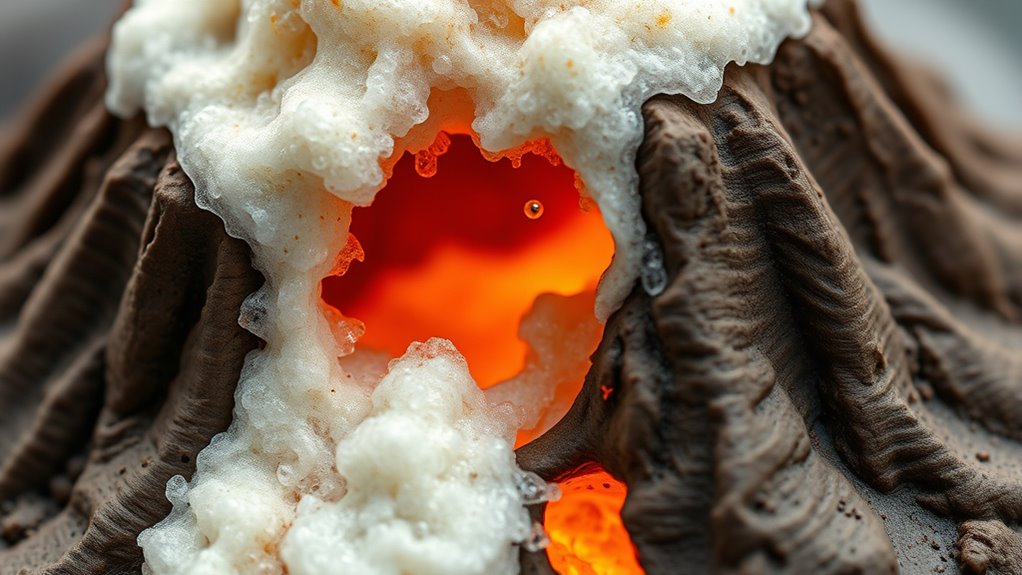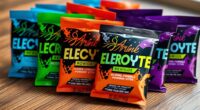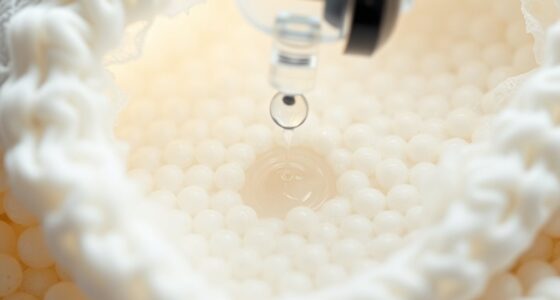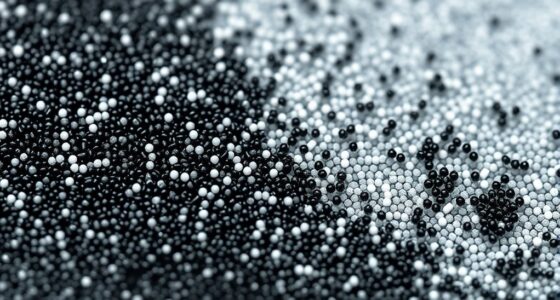Baking soda volcanoes erupt because when baking soda (sodium bicarbonate) mixes with vinegar (acetic acid), a chemical reaction occurs, producing carbon dioxide gas. This gas forms bubbles, builds pressure, and pushes foam and liquid out rapidly, mimicking a volcanic eruption. The explosion’s strength depends on how much vinegar and baking soda you use. Want to discover more about the fascinating science behind these eruptions? Keep exploring to uncover the full story.
Key Takeaways
- Baking soda reacts with vinegar to produce carbon dioxide gas, causing the eruption in the volcano model.
- The rapid gas release creates pressure that pushes foam and liquid out, mimicking a volcanic eruption.
- The reaction is an acid-base neutralization, forming water, sodium acetate, and CO₂ gas.
- Increasing vinegar or baking soda quantities intensifies the eruption by generating more CO₂.
- This demonstration visually illustrates chemical reactions, acid-base interactions, and how reactant amounts influence outcomes.
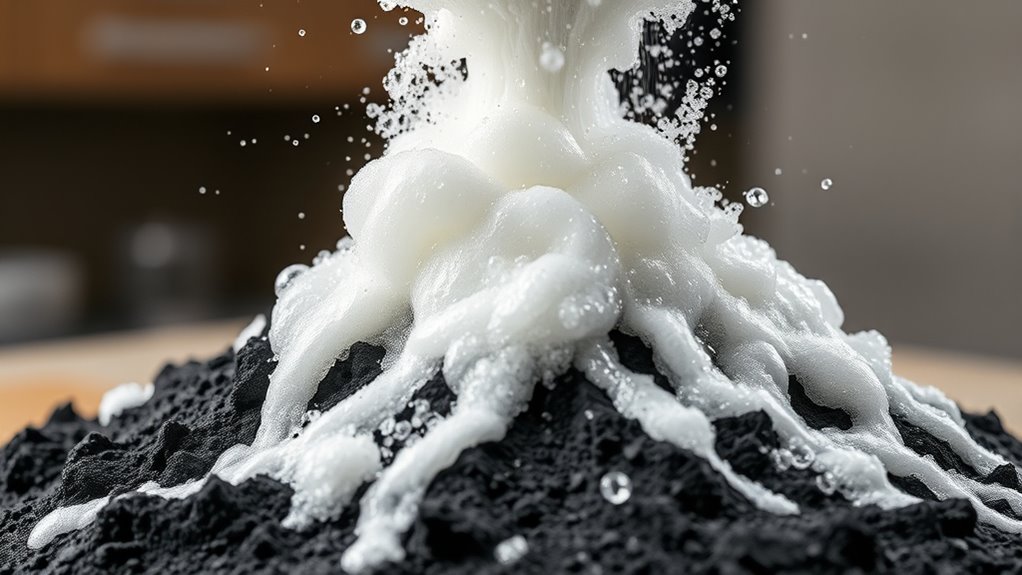
Baking soda volcanoes are a fun and dramatic way to explore chemistry in action. When you set up your volcano and add the ingredients, you’re witnessing a vivid display of chemical reactions that happen almost instantly. At the core of this eruption is an acid-base interaction between baking soda, which is a base, and the vinegar, which is an acid. This interaction produces carbon dioxide gas, the main force behind the eruption, causing the “lava” to foam and spill out in a spectacular way. Understanding these chemical reactions helps you see how everyday materials can produce powerful and interesting results.
The key to the eruption lies in the acid base interactions between baking soda and vinegar. Baking soda, or sodium bicarbonate, reacts with vinegar, which contains acetic acid, to form new substances—carbon dioxide, water, and sodium acetate. When you pour vinegar into the volcano, the acid reacts with the baking soda, releasing carbon dioxide gas rapidly. This gas forms bubbles that expand and create pressure inside your makeshift volcano.
As the gas escapes, it pushes the liquid and foam out of the opening, mimicking a volcanic eruption. This simple yet fascinating process vividly demonstrates how acids and bases interact and produce observable changes.
You can think of this reaction as a classic example of a neutralization process, where an acid and a base combine to form different compounds. In this case, the reaction is quick and produces a lot of gas, which is why your volcano erupts so energetically. The fizzing and bubbling happen because the carbon dioxide gas needs space to escape, and the foam captures the gas temporarily.
This transformation from a calm mixture to an eruptive display is a perfect example of how chemical reactions can produce unexpected and lively results from simple ingredients. When experimenting with different quantities, you can observe how the reaction rate varies, providing insight into reaction dynamics.
As you experiment further, you’ll notice that changing the amount of vinegar or baking soda alters how vigorous the eruption is. More vinegar means more acid to react with the baking soda, generating more carbon dioxide and making the eruption more dramatic. Conversely, using less will result in a smaller blast.
This gives you a hands-on way to see how the quantities of reactants influence the reaction’s intensity, reinforcing the concept of chemical reactions and the importance of reactant ratios. In essence, your baking soda volcano isn’t just a fun project—it’s a mini-lesson in acid-base chemistry and the dynamic nature of chemical reactions.
Frequently Asked Questions
How Long Does a Baking Soda Volcano Eruption Last?
You might wonder how long a baking soda volcano eruption lasts. Typically, the eruption duration is just a few seconds to maybe a minute, depending on the amount of baking soda and vinegar used.
The reaction time is quick, usually within seconds after mixing, causing the fizzy eruption. Once the reactants are exhausted, the eruption stops.
Can Baking Soda Volcanoes Be Used for Educational Purposes?
This simple chemical demonstration can light up your classroom like a fireworks show, making baking soda volcanoes perfect for educational purposes. You’ll boost student engagement as learners watch the eruption unfold in real time.
Not only do they learn about chemical reactions, but they also get hands-on experience. Use baking soda volcanoes to teach science concepts creatively, inspiring curiosity and making lessons memorable for every student.
What Are the Safety Precautions When Making a Baking Soda Volcano?
When making a baking soda volcano, you should prioritize safety. Always wear protective gear like goggles and gloves to prevent irritation from the reactions.
Set up a safe workspace away from clutter and breakables, ensuring plenty of ventilation.
Keep children supervised at all times, and have water nearby in case of spills.
Following these precautions helps you enjoy your experiment while minimizing risks and ensuring a fun, safe learning experience.
How Can I Customize the Color of the Eruption?
Think of your volcano’s eruption as a fiery canvas waiting for your artistic touch. You can customize its colors by adding food coloring to the vinegar before mixing it with baking soda.
Experiment with color mixing to create vibrant cascades or marbled effects. Just a few drops of different food colors will turn your eruption into a spectacular rainbow, making your volcano not only educational but also a stunning visual masterpiece.
Are There Alternative Household Ingredients to Create Similar Eruptions?
You can explore alternative ingredients to create similar eruptions with household items. Edible substitutes like baking powder or vinegar mixed with dish soap can produce fizzing reactions, though they mightn’t be as vigorous as baking soda.
Other options include citric acid combined with baking soda for a different bubbling effect. Keep experimenting with these alternative ingredients to find fun, safe eruptions that suit your projects!
Conclusion
Now that you understand the chemistry behind baking soda volcanoes, you see how simple ingredients create powerful reactions. Imagine a classroom experiment where a student’s homemade volcano erupts just like a real one, sparking excitement and curiosity. This hands-on activity not only teaches science but also ignites your passion for discovering how everyday substances can produce spectacular results. So next time you see baking soda, remember—you hold the power to create your own mini eruption!
